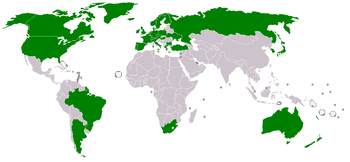- Missile Technology Control Regime
-
The Missile Technology Control Regime (MTCR) is an informal and voluntary partnership between 34 countries to prevent the proliferation of missile and unmanned aerial vehicle technology capable of carrying a 500 kg payload at least 300 km.
Contents
History
The Missile Technology Control Regime (MTCR) was established in April 1987 by Canada, France, Germany, Italy, Japan, Great Britain, and the United States. The MTCR was created in order to curb the spread of unmanned delivery systems for nuclear weapons, specifically delivery systems that could carry a minimum payload of 500 kg a minimum of 300 km.
At the annual meeting in Oslo in July 1992, chaired by Sten Lundbo, it was agreed to expand the scope of the MTCR to include nonproliferation of unmanned aerial vehicles (UAVs) for all weapons of mass destruction. Prohibited materials are divided into two Categories, which are outlined in the MTCR Equipment, Software, and Technology Annex. Membership has grown to 34 nations, with 3 additional nations, including Israel, adhering to the MTCR Guidelines unilaterally.[1]
Since its establishment, the MTCR has been successful in helping to slow or stop several ballistic missile programs, according to the Arms Control Association: “Argentina, Egypt, and Iraq abandoned their joint Condor II ballistic missile program. Brazil, South Africa, South Korea, and Taiwan also shelved or eliminated missile or space launch vehicle programs. Some Eastern European countries, such as Poland and the Czech Republic, destroyed their ballistic missiles, in part, to better their chances of joining MTCR.” In October 1994, in order to make the enforcement of MTCR Guidelines more uniform, the member states established a “no undercut” policy, meaning if one member denies the sale of some technology to another country, then all members must adhere. The ICOC, initiated by members of the MTCR, took the principles of the regime, expanded upon them, and offered membership to all nations. Thus, 117 nations now enforce export controls to curb the proliferation of UAV’s.[2]
The People's Republic of China is not a member of the MTCR but has agreed to abide by the original 1987 Guidelines and Annex, but not the subsequent revisions. China first verbally pledged that it would adhere to the MTCR in November 1991, and included these assurances in a letter from its Foreign Minister in February 1992. China reiterated its pledge in the October 1994 US-China joint statement. In their October 1997 joint statement, the United States and China stated that they agree "to build on the 1994 Joint Statement on Missile Nonproliferation."[3] In 2004 China applied to join the MTCR, but members did not offer China membership because of concerns about China's export control standards.[4][5]
Yet, the regime has its limitations. India, Iran, North Korea, and Pakistan continue to advance their missile programs. All four countries, with varying degrees of foreign assistance, have deployed medium-range ballistic missiles that can travel more than 1,000 kilometers and are exploring missiles with much greater ranges. These countries, which are not MTCR members, are also becoming sellers (except India) rather than simply buyers on the global arms market. North Korea, for example, is viewed as the primary source of ballistic missile proliferation in the world today. Iran has supplied missile production items to Syria.
In 2002, the MTCR was supplemented by the International Code of Conduct against Ballistic Missile Proliferation (ICOC), also known as the Hague Code of Conduct, which calls for restraint and care in the proliferation of ballistic missile systems capable of delivering weapons of mass destruction, and has 119 members, thus working parallel to the MTCR with less specific restrictions but with a greater membership.
Members
The MTCR has 34 members.
- Argentina, 1993
- Australia, 1990
- Austria, 1991
- Belgium, 1990
- Bulgaria, 2004
- Brazil, 1995
- Canada, 1987
- Czech Republic, 1998
- Denmark, 1990
- Finland, 1991
- France, 1987
- Germany, 1987
- Greece, 1992
- Hungary, 1993
- Iceland, 1993
- Ireland, 1992
- Italy, 1987
- Japan, 1987
- Luxembourg, 1990
- Netherlands, 1990
- New Zealand, 1991
- Norway, 1990
- Poland, 1997
- Portugal, 1992
- Republic of Korea, 2001
- Russian Federation, 1995
- South Africa, 1995
- Spain, 1990
- Sweden, 1991
- Switzerland, 1992
- Turkey, 1997
- Ukraine, 1998
- United Kingdom, 1987
- United States of America, 1987
Future Memberships
During a state visit to India in November 2010, US president Barack Obama announced US support for India's bid for permanent membership to UN Security Council[6] as well as India's entry to Nuclear Suppliers Group, Wassenaar Arrangement, Australia Group and Missile Technology Control Regime.[7][8]
See also
External links
- Missile Technology Control Regime website
- Sarah Chankin-Gould & Ivan Oelrich, "Double-edged shield," Bulletin of the Atomic Scientists, May/June 2005.
References
- ^ "Research Library: Country Profiles: Israel". NTI. 2009-10-02. http://www.nti.org/e_research/profiles/israel/index.html. Retrieved 2010-06-11.
- ^ "The Missile Technology Control Regime at a Glance". Arms Control Association. http://www.armscontrol.org/factsheets/mtcr. Retrieved 2010-06-11.
- ^ James Martin Center for Nonproliferation Studies
- ^ "China and Multilateral Export Control Mechanisms". Ministry of Foreign Affairs of the People's Republic of China. 2010-05-27. http://www.fmprc.gov.cn/eng/wjb/zzjg/jks/kjlc/fkswt/t410728.htm. Retrieved 2010-06-11.
- ^ "Missile Regime Puts Off China". Arms Control Today. Arms Control Association. November 2004. http://www.armscontrol.org/act/2004_11/MTCR. Retrieved 2010-06-11.
- ^ The Times Of India. http://timesofindia.indiatimes.com/india/Obama-endorses-Indias-bid-for-permanent-seat-in-UNSC/articleshow/6889364.cms.
- ^ "Obama seeks expanded India-US trade". Al Jazeera English. 6 November 2010. http://english.aljazeera.net/news/asia/2010/11/2010116132349390763.html. Retrieved 7 November 2010.
- ^ "Obama in Mumbai Calls India Market of the Future". Voice of America. 6 November 2010. http://www.voanews.com/english/news/Obama-Calls-For-More-Trade-with-India-106817488.html. Retrieved 7 November 2010.
Categories:- Arms control
- Guided missiles
Wikimedia Foundation. 2010.

